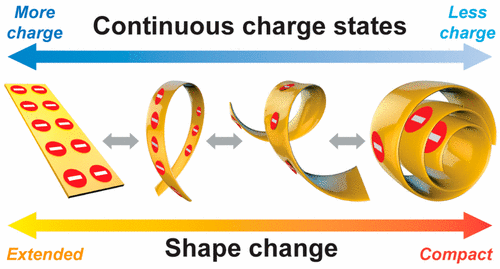当前位置:
X-MOL 学术
›
ACS Cent. Sci.
›
论文详情
Our official English website, www.x-mol.net, welcomes your
feedback! (Note: you will need to create a separate account there.)
The Relationship between Static Charge and Shape.
ACS Central Science ( IF 12.7 ) Pub Date : 2020-03-27 , DOI: 10.1021/acscentsci.9b01108 Rakesh K Pandey 1, 2 , Chi Kit Ao 1 , Weichun Lim 1 , Yajuan Sun 1 , Xin Di 1 , Hideyuki Nakanishi 2 , Siowling Soh 1
ACS Central Science ( IF 12.7 ) Pub Date : 2020-03-27 , DOI: 10.1021/acscentsci.9b01108 Rakesh K Pandey 1, 2 , Chi Kit Ao 1 , Weichun Lim 1 , Yajuan Sun 1 , Xin Di 1 , Hideyuki Nakanishi 2 , Siowling Soh 1
Affiliation

|
The amount of charge of a material has always been regarded as a property (or state) of materials and can be measured precisely and specifically. This study describes for the first time a fundamental physical–chemical phenomenon in which the amount of charge of a material is actually a variable—it depends on the shape of the material. Materials are shown to have continuously variable and reversible ranges of charge states by changing their shapes. The phenomenon was general for different shapes, transformations, materials, atmospheric conditions, and methods of charging. The change in charge was probably due to a dynamic exchange of charge from the material to the surrounding atmosphere as the shape changed via the reversible ionization and deposition of air molecules. Similar changes in charge were observed for self-actuating materials that changed their shapes autonomously. This fundamental relationship between geometry and electrostatics via chemistry is important for the broad range of applications related to the charge of flexible materials.
中文翻译:

静电荷与形状之间的关系。
材料的电荷量一直被视为材料的性质(或状态),并且可以精确而专门地进行测量。这项研究首次描述了一种基本的物理化学现象,其中材料的电荷量实际上是可变的,它取决于材料的形状。通过改变材料的形状,可以证明它们具有连续可变和可逆的电荷状态范围。这种现象普遍存在于不同的形状,变形,材料,大气条件和充电方法中。电荷的变化可能是由于材料通过可逆的电离和空气分子沉积而发生了变化,从而使材料与周围的大气层发生了动态交换。对于自动改变其形状的自致动材料,观察到了相似的电荷变化。通过化学方法在几何形状和静电之间的这种基本关系对于与柔性材料充电相关的广泛应用非常重要。
更新日期:2020-03-27
中文翻译:

静电荷与形状之间的关系。
材料的电荷量一直被视为材料的性质(或状态),并且可以精确而专门地进行测量。这项研究首次描述了一种基本的物理化学现象,其中材料的电荷量实际上是可变的,它取决于材料的形状。通过改变材料的形状,可以证明它们具有连续可变和可逆的电荷状态范围。这种现象普遍存在于不同的形状,变形,材料,大气条件和充电方法中。电荷的变化可能是由于材料通过可逆的电离和空气分子沉积而发生了变化,从而使材料与周围的大气层发生了动态交换。对于自动改变其形状的自致动材料,观察到了相似的电荷变化。通过化学方法在几何形状和静电之间的这种基本关系对于与柔性材料充电相关的广泛应用非常重要。











































 京公网安备 11010802027423号
京公网安备 11010802027423号